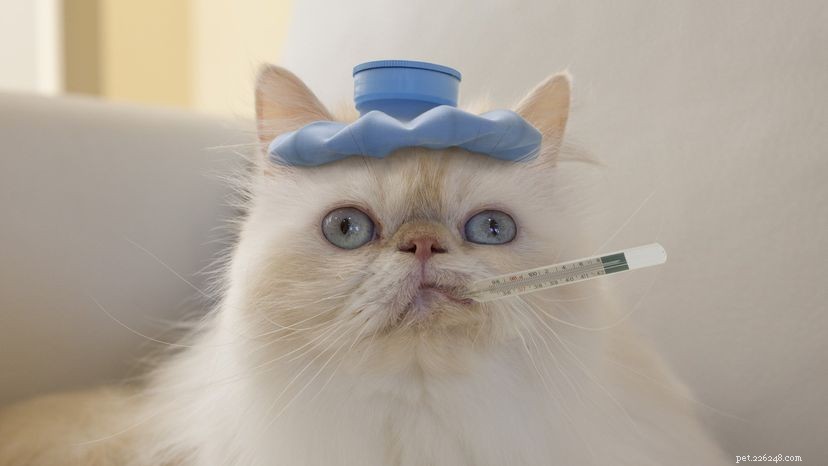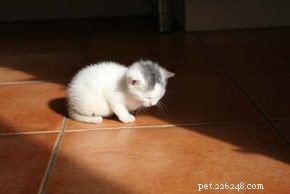Como tratar doenças comuns de gatos
 Aprender a identificar e tratar uma doença em seu gato pode ajudar a garantir uma vida longa e feliz. Ver mais fotos de gatos .
Aprender a identificar e tratar uma doença em seu gato pode ajudar a garantir uma vida longa e feliz. Ver mais fotos de gatos . Algumas pessoas têm a ideia de que os animais carregam todos os tipos de doenças perigosas. Alguns desses medos são bem fundamentados, especialmente entre animais selvagens ou exóticos. Mas a verdade é que não há muitas doenças graves que você pode pegar de um animal doméstico – e especialmente de um animal de estimação. Caso contrário, não daria animais de estimação muito bons, não é? Existem, no entanto, algumas doenças que podem ser muito graves para o seu gato. Neste artigo, revisaremos e forneceremos tratamento para várias doenças de gatos nas seguintes seções:
Noções básicas sobre doenças do gato

Antes de prosseguirmos, há alguns mitos a serem deixados de lado. Existem algumas doenças de gatos que têm nomes que soam um pouco próximos demais para o conforto de algumas doenças humanas muito graves. O vírus da leucemia felina (FeLV) causa leucemia... em gatos e apenas em gatos. O FeLV não causa leucemia nas pessoas e nem pode viver no corpo humano. Não há perigo de que um gato FeLV positivo deixe seu dono doente.
O vírus da imunodeficiência felina (FIV) se parece muito com o vírus da imunodeficiência humana (HIV), o vírus associado à AIDS. Isso não é coincidência:o FIV e o HIV pertencem à mesma classe de vírus, mas é aí que as semelhanças terminam. O FIV não infecta pessoas e não pode causar AIDS em humanos. Algumas pessoas - e até mesmo alguns veterinários - chamam o FIV de "AIDS felina" como uma maneira rápida de descrever o que o vírus faz. Infelizmente, o nome só aumenta a confusão. A AIDS é uma doença humana e o FIV é uma doença do gato.
Também não há praticamente nenhuma chance de que o resfriado do seu gato passe para você – ou, por falar nisso, que seu resfriado passe para ela. Os vírus que geralmente causam espirros, tosse e coriza e olhos em gatos não infectam as pessoas.
Os gatos podem contrair algumas das mesmas doenças que as pessoas também contraem:diabetes, artrite, doenças cardíacas e câncer, para citar algumas. Mas como nenhuma dessas doenças é contagiosa, não há como pegá-las do seu gato.
Geralmente, os gatos são considerados menos perigosos do que os cães (você não vê nenhuma história de primeira página sobre um siamês cruel que mordeu o braço de um pobre entregador), e sua reputação de limpeza dá a impressão de que eles não carregam todas as doenças. Mas, na verdade, a maioria dos veterinários prefere enfrentar um cachorro bravo do que um gato bravo. (Os gatos podem mordê-lo e esfaqueá-lo com as quatro patas.) E há algumas coisas que você pode pegar do seu gato. Aqui estão algumas das doenças do gato humano que você deve conhecer:
Pulgas. Esses pequenos insetos resistentes mordem animais de sangue quente e usam seu sangue como alimento. As pulgas são tão pequenas que uma única mordida é quase imperceptível (a menos que você ou seu gato sejam alérgicos, caso em que coça como um louco). Uma infestação de pulgas completa, no entanto, pode tirar tanto sangue de um animal que se torna anêmico.
Felizmente para nós, as pulgas preferem a temperatura corporal mais quente de cães e gatos aos nossos 98,6 graus Fahrenheit. Mas uma pulga faminta tomará qualquer porto em uma tempestade, e uma pulga pulará de um gato infectado para tapetes, cortinas, móveis e depois para você para um lanche rápido.
Há alguma preocupação de que doenças transmitidas pelo sangue possam ser transmitidas por pulgas, mas isso significaria que a pulga que morde você teria que ter picado outra pessoa com uma doença transmitida pelo sangue, o que é possível, mas altamente improvável. Os maiores perigos das pulgas são o incômodo e a coceira das picadas.
Marca. Estes também são insetos sugadores de sangue. Os carrapatos são um pouco maiores do que as pulgas, especialmente depois de se prenderem a um hospedeiro e incharem. Assim como as pulgas, os carrapatos não são tão propensos a abandonar seu gato por você, mas isso pode acontecer. Além disso, se o seu gato esteve em algum lugar onde os carrapatos ficam, as chances são de que você também esteve lá ou seu gato os trouxe para casa. Novamente, o problema mais comum é o aborrecimento. No entanto, os carrapatos podem transmitir duas doenças graves:a febre maculosa das Montanhas Rochosas e a doença de Lyme.
A melhor proteção contra essas duas doenças é a remoção imediata e completa dos carrapatos. Algumas gerações de escoteiros aprenderam que a melhor maneira de remover um carrapato é queimar sua bunda com um cigarro ou uma cabeça de fósforo fumegante. Bem, além do fato de que os escoteiros não deveriam fumar, a estratégia de despejar um tique-taque-por-fogo não é a melhor escolha.
A melhor maneira de remover um carrapato é usar uma pinça para segurar o carrapato o mais próximo possível da linha da pele. Puxe-o para fora, com firmeza, mas suavemente, com pressão lenta e uniforme. Isso deve remover todo o carrapato - incluindo a cabeça. Os carrapatos são muito resistentes, então coloque-o em uma pequena garrafa de álcool para se certificar de que está morto (e para preservá-lo para o seu veterinário, se o seu gato mostrar algum sinal de doença). Então, depois de remover o carrapato, aplique um antisséptico tópico ou pomada antibiótica na área.
Minhocas. Esses pequeninos podem viver em seu trato digestivo sem que você perceba que eles se estabeleceram. As minhocas podem ser apanhadas pelo manuseio descuidado das caixas de areia e do solo que os gatos usaram como caixa de areia. As crianças correm um risco particular de pegar vermes dessa maneira.
Os vermes são muitas vezes difíceis de detectar, pois vivem dentro do corpo. A dica geralmente é algum tipo de problema digestivo que não desaparece e não tem outra explicação. Também é uma boa ideia levar uma amostra das fezes do seu animal de estimação ao veterinário para exame microscópico de vermes e ovos de vermes. Os vermes podem ser tratados de forma rápida e segura assim que são diagnosticados.
Tinhais. Este não é realmente um verme. É um fungo que se instala na pele, causando manchas carecas e escamosas que geralmente são cercadas por um anel vermelho. Os gatos são notórios por serem portadores assintomáticos de micose, o que significa simplesmente que eles podem transportar o fungo para sua casa (e para você) sem nunca mostrar nenhum sinal. Claro, muitos gatos também mostram os sinais.
Quer o seu gato mostre os sinais ou você (ou ambos), você provavelmente terá que tratar toda a casa, assim como todos os gatos da casa. Os esporos de micose podem sobreviver nos cantos e recantos de sua casa por meses. Os tratamentos podem incluir a desinfecção de sua casa, pomadas ou loções tópicas para as manchas escamosas, banhos ou banhos para o seu gato e medicação oral.
Raiva. Isso é um negócio sério. A raiva é uma doença fatal. Além do mais, uma vez que a doença se instala, não há muito que possa ser feito para detê-la. A melhor defesa contra a raiva é um ataque forte. Um gato dentro de casa quase não tem chance de ser exposto à raiva, mas a aposta mais segura é dar ao seu gato uma vacina contra a raiva e mantê-la atualizada. A raiva é transmitida pela mordida ou arranhão de um animal infectado, então toda vez que um gato ao ar livre se envolve com outro gato ou se envolve com a vida selvagem local, há uma chance de contraí-lo.
A raiva infecta todos os animais de sangue quente, incluindo pessoas. Qualquer mordida ou arranhão de um animal - mesmo um que você conhece e que esteja atualizado com suas vacinas contra a raiva - deve ser tratado como potencialmente perigoso. Nunca é exagero procurar atendimento médico para uma mordida de gato ou arranhão de gato grave.

Doença da arranhadura do gato (também conhecida como febre da arranhadura do gato). Algumas pessoas insistem que a febre da arranhadura do gato é um mito, mas na verdade é uma doença clinicamente comprovada. Arranhões e mordidas de gatos podem se transformar em infecções graves literalmente da noite para o dia. Mordidas de gato, em particular, precisam de atenção cuidadosa. Lave bem as mordidas ou arranhões graves e chame seu médico para aconselhamento. Você pode precisar de um reforço de tétano ou uma injeção de antibiótico para prevenir a infecção.
Toxoplasmose. O Toxoplasma gondii é um parasita protozoário (organismo unicelular) que pode causar uma doença neurológica em humanos. Este protozoário é passado nas fezes de gatos infectados, que por sua vez o pegam de animais infectados que mataram e comeram. Os gatos são o que chamamos de vetor primário para o organismo do toxoplasma, o que significa que o ciclo de vida do parasita depende de passar pelo menos um pouco de tempo no corpo de um gato.
Os gatos geralmente não apresentam muitos sintomas quando estão infectados com toxoplasmose - e uma pessoa que a pega geralmente também não. Pode haver alguns sintomas leves que são passados como resfriado ou gripe, mas geralmente é só isso. As duas principais exceções são pessoas cujo sistema imunológico está enfraquecido (como alguém em quimioterapia ou uma pessoa com AIDS) e mulheres grávidas.
Talvez até 70% dos adultos já tenham sido infectados pela toxoplasmose e agora estejam imunes. Embora os gatos sejam o principal vetor desse parasita - e teoricamente é possível pegar toxoplasmose pelo manuseio descuidado de caixas de areia ou inalação de esporos de toxoplasma ao limpar a caixa de areia - a maioria das pessoas pega toxoplasmose ao cavar sujeira contaminada por fezes de gatos ou manusear ou comer carne crua ou mal cozida.
Estas são as doenças básicas com as quais você deve se preocupar. Na próxima seção, mostraremos os primeiros sinais de alerta de que seu gato contraiu uma doença perigosa.
Primeiros sinais de doença do gato

"Prevenido é feito de antemão", diz um bom ditado popular. Em termos um pouco menos floridos, isso significa simplesmente que, se você souber o que esperar - ou o que procurar - estará melhor preparado para lidar com o que vier.
Podemos dizer se uma pessoa está se sentindo mal por sua expressão facial... ou porque ele é uma daquelas pessoas que adora falar sobre cada pequena dor e dor. Bem, a pele de um gato é completamente coberta de pelos, ela tem apenas algumas expressões faciais e não pode falar, então cabe a você conhecer os sinais sutis - e não tão sutis - de que algo pode estar acontecendo. errado.
Avisos antecipados
Sempre que algo não está bem com o seu gato, geralmente há sinais de alerta precoces. Infelizmente, os sinais podem ser tão leves quando aparecem pela primeira vez que você pode facilmente perdê-los. Outras vezes, você pode notar algo um pouco diferente no seu gato, mas parece inofensivo – e até fofo. Lembre-se de que os primeiros sinais de alerta podem se acumular tão lentamente ao longo de um período de tempo tão longo que, no momento em que você os percebe, eles não são mais alertas precoces.
Quando você tem um gato doente, nada é pior do que uma visão retrospectiva 20/20 - aquela sensação terrível de não ver algo chegando quando todos os sinais estavam lá. Para ajudar a poupar você de tudo isso, aqui estão algumas coisas importantes a serem observadas:
Mudanças de comportamento. Seu gato geralmente amigável tornou-se mais temperamental, tímido ou sensível ao ser acariciado ultimamente? Ou seu gato geralmente mal-humorado ou tímido se tornou visivelmente mais amigável? Qualquer tipo de mudança de personalidade em um gato pode ser um sinal de um problema de saúde do gato em desenvolvimento.
Novos comportamentos ou aumento da frequência de comportamentos também podem ser um aviso precoce, como um gato que nunca bebeu da torneira de repente aprendendo o truque ou um gato "com coceira" coçando ou esfregando as orelhas com mais frequência. Da mesma forma, se o seu gato parece mais sedento (bebe com mais frequência ou por longos períodos de tempo), ele pode estar dizendo que tem um problema renal, diabetes precoce ou simplesmente que está um pouco seco em casa.
Veja bem, é importante enfatizar aqui que esses alertas comportamentais precoces são apenas isso:alertas. Eles não significam necessariamente que há um problema sério com seu gato, que ele tem algo que pode se transformar em um problema sério, ou mesmo que há algo de errado com ele. Se você perceber um sinal de alerta precoce, fique de olho no seu gato para ver se o sinal de alerta continua ou piora.
Ligue para o seu veterinário o quanto antes e discuta o que você viu. Seu veterinário pode sugerir marcar uma consulta para um exame ou apenas fazer algumas perguntas e dar outras pistas para você ficar de olho.
Lembre-se, qualquer tipo de mudança de comportamento pode ser significativa, não importa quão leve ou sem importância possa parecer. Ser um bom observador de gatos não só ajuda a detectar problemas de saúde emergentes cedo – quando eles têm a melhor chance de serem tratados com sucesso – como também pode lhe dar uma apreciação mais profunda do comportamento bonito e complexo dos gatos.
Mudança na aparência. Parece haver um pouco menos do seu gato por aí nos dias de hoje? Ou talvez um pouco mais? Supondo que sua dieta e apetite sejam os mesmos, um ganho ou perda de peso pode estar lhe dizendo que algo potencialmente mais sério está acontecendo dentro do corpo do seu gato. O cabelo dela parece mais fino? Mais grosso? Perdeu o brilho saudável? Uma pelagem sem brilho, perda excessiva de cabelo ou pele seca, áspera ou quebradiça também são sinais importantes de possíveis problemas de saúde.
É claro que as mudanças na aparência são naturais com o avançar da idade, incluindo alguma perda de massa corporal ou pelo um pouco mais desalinhado. Mas mesmo essas mudanças normais são sinais importantes; eles estão dizendo que agora você tem um gato idoso cujas necessidades vão mudar junto com seu corpo.
Mudanças no apetite e eliminação. Os gatos são notórios por serem comedores exigentes. Mas, na verdade, a delicadeza não é realmente uma parte normal do comportamento do gato. Em geral, os gatos torcem o nariz para a comida pelas mesmas três razões pelas quais as crianças fazem:não tem um gosto bom; eles estão esperando por algo melhor (e sabem que vão conseguir se recusarem o que lhes foi dado); ou eles não se sentem bem.
Se o seu gato está comendo constantemente a mesma dieta e de repente perde o entusiasmo, não assuma que ele está cansado da mesma comida antiga. Se podemos comer o mesmo cereal matinal ou tomar o mesmo café e pastelaria dinamarquesa todas as manhãs, não há razão para que seu gato não fique satisfeito com o mesmo menu todos os dias. Deixar de comer (ou, nesse caso, ficar com fome) é outra maneira de seu gato deixar você saber que não está se sentindo bem.
Como os gatos usam a caixa de areia, você pode não notar uma mudança nos hábitos de eliminação imediatamente. Por mais desagradável que possa parecer, é uma boa ideia pelo menos estar ciente do que você está pegando ou despejando da areia do gato. Um aumento ou diminuição acentuada na urina ou fezes, a presença de sangue ou muco, ou um cheiro particularmente pungente (quando a caixa foi limpa recentemente) são todos avisos de possíveis problemas à frente.
Da mesma forma, um gato que é treinado na caixa de areia, mas de repente parece esquecer, está enviando uma mensagem para você. Pode ser uma questão comportamental, de estresse ou ambiental, mas também pode ser desencadeada por vermes, uma infecção da bexiga ou outros problemas potencialmente graves.
Muitas vezes é difícil identificar se uma mudança é estritamente no comportamento, aparência ou apetite e eliminação. Por exemplo, andar de um lado para o outro pode ser considerado uma mudança de comportamento ou uma indicação de uma glândula tireoide hiperativa, e um gato que arrancou pedaços de cabelo tem uma mudança na aparência que pode vir de uma mudança de comportamento. Além disso, as mudanças podem acontecer em um período de dias, semanas ou meses - ou podem simplesmente aparecer de um momento para o outro.
Mudanças repentinas ou abruptas são mais fáceis de perceber. Mudanças de longo alcance se acumulam ao longo do tempo, geralmente tão lentamente que não as percebemos até que tenham feito algum progresso significativo.
Vamos voltar ao diabetes como exemplo. Um gato que desenvolve diabetes beberá mais e fará idas mais frequentes à caixa de areia, produzindo maiores volumes de urina. Seria quase impossível notar seu gato fazendo apenas uma viagem extra para a tigela de água ou caixa de areia ao longo de uma semana, e ainda seria bastante difícil, mesmo quando aumentado para uma viagem extra todos os dias. E até mesmo várias viagens extras por dia também podem passar despercebidas, especialmente porque os gatos são noturnos e a maioria das pausas adicionais para água ou caixa de areia podem ocorrer enquanto você dorme.
No momento em que você está pensando:"Nossa, esse gato parece estar gastando muito tempo na tigela de água ou na caixa de areia", ela provavelmente está no nível de várias viagens extras por dia. Você deve se treinar para observar os hábitos diários do seu animal de estimação para que possa detectar e relatar quaisquer mudanças sutis e graduais ao seu veterinário.
Agora que você notou um problema com seu gato, agora você tem que decidir se este é um problema que você pode resolver em casa ou se você precisa da ajuda do seu veterinário. Daremos algumas dicas para tomar essa decisão na próxima seção.
Quando chamar o veterinário

É claro que os avisos antecipados de nada adiantam se você não fizer algo a respeito. Você deve verificar todos os indicadores de possíveis problemas de saúde com seu veterinário o mais rápido possível, apenas para ter certeza. Mas há outros momentos em que uma chamada para o veterinário - ou uma ida direto ao hospital de animais - é uma prioridade neste minuto.
Qualquer situação de emergência. The common sense definition of a veterinary emergency is when you would call the doctor for yourself if it happened to you. Emergencies where you should take a cat to the vet would therefore include:
Any symptom that persists more than 48 hours or worsens (even a relatively mild one). Let's say you notice your cat has started sneezing a lot. It could be that she just crawled into a dusty nook somewhere, or it could be the start of a feline cold. If the sneezing doesn't go away after several hours, the cold begins to look like the more likely choice. If your cat is still sneezing a lot by the second day, it's pretty clear it's not going away by itself any time soon and it's time to call the vet.Of course, if any symptom worsens suddenly or interferes with your cat's breathing, eating, drinking, walking, or elimination, don't wait 48 hours. Call the vet immediately.Now that you know the fundamentals of cat disease, we will start to get into the particulars. We will begin in the next section with discussion of cats with asthma.
How to Treat Cats With Asthma

Asthma is a chronic breathing problem. Both cats and people suffer from it, but it isn't contagious. An asthmatic cat (or person) has bouts of extremely difficult breathing called asthma attacks. An asthma attack is fairly easy to spot; you'll notice rapid, open-mouthed breathing accompanied by wheezing and often by forced exhalations.
Because breathing is so severely restricted during an asthma attack, the cat's gums and tongue may take on a bluish color. (Do not try to give mouth-to-mouth resuscitation or CPR to a cat having an asthma attack.)
Asthma often develops from another breathing problem called allergic bronchitis. This is pretty much what it sounds like:The airways in the cat's lungs get inflamed as the result of an allergic reaction to inhaled germs, dust (including dust from litter), wood smoke, and other irritants.
Usually the cat has no other major signs of illness, a normal temperature, and continues to eat well. The only telltale sign is that she just has fits of deep, moist-sounding coughing. If the allergic bronchitis goes untreated or the source of the allergy isn't removed, the lungs can be permanently damaged, resulting in emphysema and asthma. Once the damage is done, even removing the original cause or causes of the allergic bronchitis won't make asthma go away.
Recently, some studies have been done on the effects of secondhand smoke on pets. The news is about what you'd expect:Secondhand smoke isn't particularly good for your cat. Cats with asthma or other breathing problems suffer more from secondhand smoke. Remember, asthma is related to allergies, so anything that irritates the air passages of the lungs -- including cigarette smoke -- can trigger an asthma attack.
What to Do
Reduce stress. Stress makes allergies and asthma worse. Right about now you're saying to yourself, "Stress? What the heck kind of stress does a cat have?" That's a fair question. They certainly don't have to worry about paying bills or where their next meal is coming from. (Those are your stresses, actually.) They don't have job pressures or deadlines to meet. Heck, they don't even have to think about what they're going to wear every day.
Cats have stress that we like to call "domestication stress" or "family stress." You see, cats weren't originally designed and built to live among humans. They've done a superb job of adapting, but no matter how independent and primal your cat seems, she's still having to deal with the human world and human civilization every single day. And that gets tough. Giving her plenty of options to do cat things such as run, climb, stalk (preferably another cat), bat things around, hide, and nap in secluded spots helps her cope.
If the stress level goes up in your life or in your household, it goes up in your cat's life, too. She can't understand why things are getting tense -- she just knows people are moving and sounding anxious. Remember, "stress" doesn't just mean negative things; positive events carry stress, too. In fact, probably the worst kind of stress for a cat is change.
A new baby, for instance, is not only a time for great joy but also for great change -- and the stresses that go with that. For you, those stresses mean less sleep (or none at all), a change in lifestyle, and an extra mouth to feed. For your cat, it means some strange new animal, who makes odd noises, smells funny, and doesn't do much, suddenly takes all the human attention away from her!
Clear the air. Secondhand smoke isn't the only thing that can make asthma worse. Even things that we think make our home more pleasant can be a no-no for a cat with bronchitis or asthma. Perfumes, room fresheners, deodorizers, and even scented litters or litter additives can trigger allergy and asthma attacks.
Likewise, the fumes from paints, cleaners, varnishes, and new carpeting are actually chemical irritants that create problems for the asthmatic cat. Use natural objects, such as flowers, eucalyptus sprigs, and fresh floral potpourri, to provide a fresh scent to a room instead of sprays or solids that contain chemicals. Use strong-smelling paints, stains, cleaners, and solvents in well-ventilated rooms, and keep the cat out until the smell goes away. And put out those smokes.
It's a good idea to use plain, natural, unscented litter and to stay away from deodorizers you add to the litter. Also the dust from the litter itself irritates the lungs and can cause attacks in asthmatic cats. Some natural litters -- like the ones made of recycled paper -- have virtually no dust at all. To cut down on dust from clay litters, pour them slowly, keeping the opening of the bag just a few inches from the litter box.
Wetter is better. Dry air dries out the lining of your cat's air passages, encouraging coughing and making your cat more vulnerable to infection and allergic reactions. Be sure to have a good humidifier going, especially in winter, during heating season, and in arid areas of the country. There's an added bonus to this remedy:You will also be less likely to have as many coughs, stuffy noses, and colds in the air if your home is kept properly moist.
Moderation in all things. A sedentary cat is more prone to health problems, but a cat who already has asthma can have a severe attack if she exerts herself too much. On the other hand, if she barely exerts at all, her breathing will be more labored because her heart and lungs aren't fit. Plus, she'll probably gain weight, and the heavier the cat, the more trouble she'll have with her asthma.
Stick to the right amount of a high-quality, healthy diet; cut out the snacks and treats; and make sure your cat stays active. Get her a feline playmate and a good supply of toys. Be certain to play with her yourself, but keep the play sessions short and low-impact.
When to Call the Vet
Any full-blown asthma attack is a medical emergency, which means your cat needs immediate veterinary medical care. Likewise, if your cat gasps for air, collapses, or turns blue in the gums and tongue, don't wait to take her to the animal hospital. Milder signs (such as noisy breath, occasional and intermittent wheezing or moist coughs, or slightly labored breathing after exertion) aren't emergencies, but you should get your cat to the vet as soon as possible. They could be caused by something other than allergies. And if it is bronchitis or the start of asthma, your vet may be able to give your cat medication that can prevent the danger and fright of a full-blown attack.
DANGER LEVEL: Dangerous; a severe asthma attack can be fatal.
In the next section, we will examine how to treat your cat if she has urinary tract disease.
How to Treat Cats With Cystitis

A cat's bladder can become inflamed because of infection or irritation. Cystitis most often happens as part of a collection of bladder and urinary problems commonly called feline urological syndrome (FUS) or feline lower urinary tract disease (FLUTD).
Attacks of cystitis or FUS (which includes cystitis, along with inflammation of the urinary tract and the formation of stones or sand in the bladder) are announced by bloody urine, frequent urination of small amounts, litter box accidents, spraying, excessive licking of the urinary opening, straining in the litter box, and possibly tenderness of the lower abdomen.
The pH of a cat's urine -- how acidic or alkaline it is -- has a lot to do with cystitis and FUS. If the cat's urine is alkaline, it's much easier for urinary crystals to form. These crystals in turn form gritty "sand" or small stones that irritate the lining of the bladder and can plug up the urinary opening in male cats, which is an extremely serious problem.
What to Do
Serious complications of cystitis and FUS show up most often in adult male cats. The first flare-up usually occurs when the cat is fairly young, and repeat bouts can pop up for the rest of his life. That having been said, don't think that just because you have an older or female cat that you're in the clear:Urinary tract problems can strike any cat.
Food for thought. Most experts agree that many factors, including diet, contribute to a cat's susceptibility to developing FUS. Plant-based cat foods tend to make a cat's urine more alkaline (higher pH), which encourages the formation of crystals and stones and is a more hospitable environment for bacteria. Some commercial dry cat foods seem to have the same effect on urinary pH. As a result, cats who develop cystitis or FUS should only eat dry foods recommended by a veterinarian or stick to prescription dry food specially formulated for cats with bladder problems.
Your vet may also suggest a urinary acidifier to add to your cat's diet, making sure the pH of his urine stays low enough to prevent bladder stones, or may recommend a special diet formulated to dissolve crystals or stones in the bladder.
Magnesium is an important trace nutrient that every cat needs. Unfortunately, some commercial cat foods provide it in a form that also encourages crystals to form in the cat's urine, which can lead to bladder stones and, which, in turn, can cause a urinary obstruction. A quality commercial canned food is usually relatively low in magnesium, easy to digest, produces more acidic urine, and provides more fluid intake.
Water, water everywhere. The body is an amazing thing:If it doesn't have enough of something it needs, it finds a way to get it. If a cat isn't drinking enough, his body will find a way to conserve and reclaim water. One way is by reabsorbing water from the urine, making it more concentrated. The urinary tract lining in cats that have already had a bout of cystitis or FUS is particularly sensitive, and concentrated urine can trigger additional attacks.
Make sure your cat has constant access to plenty of clean, fresh water. Watch for your cat's drinking preferences -- some favor a water faucet or even the toilet over a water bowl on the floor. It might seem odd or even a little bit disgusting, but it's probably a good idea to cater to his water-drinking whims, especially if the option is a flare-up of bladder disease.
Cats also get water from their food. The higher the moisture content in his diet, the more water he's getting -- even without drinking. A cat who eats canned food gets a lot of water with the meal and more as a result of breaking down the higher fat, higher energy ingredients that are in most wet foods.
Less stress. The "body-mind connection" works for cats just as well as it does for people. Country folks know that a healthy attitude toward life makes for a healthy body. Unfortunately, you can't explain that to your cat. Instead, it's up to you to minimize his stress and maximize his health.
Try to anticipate problems. Do you know a major change is coming up in your household? Whether it's a new baby, someone going off to college for the first time, a family vacation, or remodeling the kitchen, if you know it's coming it's best to either ease the cat into it slowly or expect an attack of urinary problems and take the necessary precautions.
You should have realistic expectations for your cat. Sure, cats are clever and agile and maybe even a little sneaky, but they're still cats. It's entirely possible that your cat understands everything you say and is just playing dumb or being obstinate.
However, it's equally possible that he's only learned how to get along in human society just well enough to find himself a comfortable situation and doesn't have a clue why you're so bent out of shape that he's been urinating in your beautiful potted plants instead of the convenient litter box you bought him.
Also, if a cat doesn't understand why he's being reprimanded, he stresses out. A stressed cat will announce his unhappiness with a change in behavior, often by elimination. And, to a cat, leaving it where you're sure to notice it -- where your personal smell is strongest -- is a great way to guarantee you'll get the message.
Finally, to lessen your cat's stress, try to stay cool yourself. Have you ever tried to enjoy a favorite activity and then had someone who was really, really intense about it right next to you? To cats, life in your home is basically one long stay at a resort hotel:The weather is always fine, everything is already paid for, you don't have to work, and you can eat, sleep, and play whenever you like.
If the humans in this little paradise are under stress, though, the vacation is suddenly over. Some of this may be cats' fabled sensitivity to people's emotions, but some of it certainly is a reaction to the changes in the way we humans move and speak when we're agitated.
Check the box. A clean litter box filled with the appropriate kind of litter must be available to the cat at all times. Using the litter box is not an instinctive behavior in cats; the instinct part is the action of digging in loose materials to bury their urine and feces (especially if there is a habit of using that spot or the very faint residual smell of elimination there). If something turns them off to the box (like it's too dirty, too perfumey, or too much trouble to get to), they'll either hold it too long (increasing bladder irritation and the risk of infection) or find another "toilet." Check your cat's litter box regularly, making sure it is clean and free of irritants.
When to Call the Vet
Cats with urinary tract problems will often deliberately urinate outside of the litter box, even if they've been 100 percent accurate all their lives. If your cat suddenly starts having "accidents," spraying urine, or squatting and straining outside of the box, don't punish him. He's probably telling you he's got a problem. Call the vet as soon as you notice one of these signals and schedule an appointment for an exam. If it's a physical problem, the sooner your catch it, the easier it will be to treat. If it's a purely behavioral thing, you can start correcting it before it becomes an ingrained habit.
If your cat is straining in the litter box (or elsewhere) and not producing any urine, produces small amounts of bloody urine, or cries during urination, call the vet immediately. These are the signs of a urinary blockage, an extremely serious -- and potentially fatal -- problem.
DANGER LEVEL: Most bladder problems by themselves are not dangerous; they're mostly inconvenient and a nuisance for the owner. However, urinary blockage is extremely dangerous and should be treated as a life-threatening situation.
Next we will deal with a disease that is just as serious for cats as it is for humans -- diabetes.
How to Treat Cats With Diabetes

The pancreas is a long gland that lies directly beneath the stomach. A cluster of specialized cells in the pancreas produce insulin, which regulates the body's uptake and breakdown of sugar. Diabetes mellitus (usually just called diabetes or sugar diabetes) is the result of a shortage of insulin. Diabetics have intense thirst, produce large amounts of urine, and have abnormally high levels of sugar in their blood and urine. Other signs of diabetes are increased appetite and slow healing.
Left untreated, the diabetic cat will lose weight (despite eating more) and become lethargic. Later signs of untreated diabetes include vomiting, diarrhea, rapid breathing, weakness, and finally collapse and death.
Your vet's diagnosis of diabetes is based on the cat's clinical signs, physical exam findings, and laboratory test results, primarily a persistent presence of abnormally high levels of sugar in the blood and urine.
Diabetes is a disease of older cats, rarely occurring before the age of seven years. It can be managed through diet and, when necessary, supplementary insulin. With treatment, diabetic cats can live ordinary lives, and a few may return to normal function for reasons that are not well understood.
What to Do
Watch that weight. Obese cats are more likely to develop diabetes. In fact, cats who weigh in at 15 pounds or more have double the risk of diabetes than the under-15-pound crowd. Keeping your cat's weight under control is a simple formula:Feed only the recommended amounts, limit (or eliminate) snacks and treats, and make sure Tabby stays active.
You are what you eat. A high-fiber diet helps control diabetes by regulating the rate at which nutrients are taken into body cells. This, in turn, keeps blood sugar levels more consistent. Feeding several small meals during the day has a similar effect on blood sugar. A couple of large meals spread several hours apart cause a post-meal blood sugar surge, followed by a below-normal level by the time the next meal comes around. A normal cat's body smooths out these peaks and valleys, but it's a problem for diabetics. Many diabetic cats can have their blood sugar levels returned to normal through diet and weight loss alone.
Be prepared. One of the most important aspects of managing the health of a diabetic cat is consistency. Food and medication must come at regular times, so be sure you always have an adequate supply of both and never skip or substitute.
Occasionally, a diabetic cat on insulin will have her blood sugar level suddenly swing dangerously to the low side -- a condition known as hypoglycemia. Signs of hypoglycemia include shaking, disorientation, salivating, staggering and falling, and seizures. Keep an emergency sugar source on hand at all times (honey or Karo syrup are the usual recommendations). At the first sign of hypoglycemia, rub some on the cat's gums -- and call the vet immediately.
When to Call the Vet
If your cat shows signs of diabetes, schedule a veterinary exam as soon as possible. The longer a diabetic cat goes untreated, the more serious her condition gets. The earlier you can catch and control her diabetes, the more likely she is to have a normal life.
A cat who's already being treated for diabetes needs to go to the vet immediately if she shows signs of hypoglycemia or any kind of reaction to her medication.
DANGER LEVEL: Untreated diabetes and hypoglycemia are extremely dangerous; however, both can be treated and controlled.
While diabetes is a serious problem for cats, we will discuss an even more dire condition in our next section -- FIV, or what is commonly referred to as "feline AIDS."
How to Treat Cats With Feline Immunodeficiency Virus

FIV, FIP, and FeLV are three extremely serious, incurable, and usually fatal cat diseases caused by viruses. Each is caused by a different kind of virus. However, they are all contagious only between cats, and have the interesting quirk that not all cats exposed to them will get sick.
Unlike the viruses that cause upper respiratory diseases or distemper in cats and can be carried in the air, these three require the physical presence of an infected cat in the same place (although not necessarily at the same time) as the cat who catches it. FIP and FeLV are spread most often by prolonged close contact with an infected cat.
Close contact can include mutual grooming or sharing food, water, elimination areas, or sleeping quarters. This means a cat who goes outdoors and urinates or defecates where a cat carrying FIP or FeLV goes can catch the virus without ever having had physical contact with the carrier. FIP and FeLV can also be spread to kittens by a mother with the virus.
The main route of infection for FIV appears to be a bite from an infected cat. Cats who go outdoors -- particularly if they fight -- are therefore at risk. The most common profile of an FIV-positive cat is an unneutered male who goes outdoors and has sustained bites and scratches from other cats.
Cats who appear otherwise healthy may be carrying these viruses. Reliable blood tests exist for FeLV and FIV. There is a test for FIP; however, a positive FIP test alone -- without other symptoms or risk factors -- is not absolute proof the cat has the virus.
FIV is sometimes also called feline AIDS (or FAIDS). FIV does have a few general similarities to HIV, the virus associated with AIDS:It belongs to the same class of viruses, can stay in the body for years without causing illness, and when it becomes active, slowly breaks down the disease-fighting immune system. However, AIDS is a human disease, and FIV cannot infect humans.
What to Do
Take the test. Since a cat can appear healthy and still carry one of these viruses, a new arrival -- even your first cat -- should be tested for FeLV. Kittens probably don't need FIV tests unless they were strays, but it's probably a good idea to test adult cats from any source. Your veterinarian may recommend a retest in a few months. This isn't a scam; if your cat was very recently infected, it may not show up on the first test.
Stop the spread. There's only one surefire way to prevent your cat from contracting FeLV, FIP, or FIV:Keep her away from the sources of the viruses. In other words, keep her away from other cats and the places they frequent. This usually means keeping cats indoors at all times. It definitely means testing any new cat added to your household for FeLV and FIV before she's allowed to meet the resident cat or have run of any of the same areas. Preventative vaccines are available for FeLV and FIP. Schedule an appointment with your vet to talk about the advisability of vaccinating your cats for these diseases.
Be positive about positives. If your cat tests positive for FeLV or FIV and a retest confirms it, don't give up hope. With good care, FeLV- and FIV-positive cats can live for years, even after signs of disease appear. New treatments are coming all the time, and there may be a breakthrough that will help your cat long before she gets seriously ill.
Be responsible about the news. Keep your cat away from uninfected cats, and don't add any FeLV- or FIV-negative cats to your household. It may be tempting to start taking in other FeLV- and FIV-positive cats who are facing euthanasia, but think it over carefully. Eventually, the disease will catch up with them, and they'll demand a lot of time and resources. It may be best to focus on the special status of your own cat and give her the best possible quality of life.
Treat the symptoms. Most of what you can do for cats who are sick with FeLV, FIP, or FIV is just make them feel better. This might be as simple as indulging them with their favorite foods when their appetites are poor or coaxing them to eat with petting and hand-feeding. However, each virus has its signature complications that may also need attention, usually from the vet and with follow-up or nursing care at home. FeLV causes lymphosarcoma, a kind of cancerous tumor that may need to be removed.
The "wet" (effusive) form of FIP causes fluid to build up in the chest, making breathing difficult, or in the abdomen, giving the cat a bloated appearance. This buildup is a problem your vet can sometimes relieve by suctioning out the fluid with a needle and syringe. Since FIV attacks the immune system, you'll have to stay on top of secondary infections with prevention and medication.
When to Call the Vet
These three viral diseases are a strong case for annual veterinary checkups. The early signs of any of the diseases are often too subtle for the average cat owner to notice, but a veterinarian knows what to look for. In between checkups, notify your vet of any sudden abdominal bloating or swelling, low-grade signs of illness that never quite go away (sneezing or diarrhea, for example), any lumps on your cat's body, or bites or scratches from cats not known to be FeLV- and FIV-negative.
Cats who have been diagnosed with FeLV, FIP, or FIV should see the vet regularly.
DANGER LEVEL: All three of these diseases (FeLV, FIP, and FIV) are extremely dangerous. Although surprisingly few cats exposed to these viruses will get sick from them, once the illness begins it is almost always fatal.
Kidney disease in cats is not nearly as fatal as FIV, but it can still be quite serious. Learn more in the next section.
How to Treat Cats With Kidney Disease

The kidneys' major job is filtering out wastes. Age, injury, or disease can damage and destroy the function of kidney tissue. The body can adjust to minor kidney damage or the early stages of kidney failure, so there may be no noticeable signs at first.
As damage or failure worsens, a cat produces more urine and drinks more to compensate. In the later stages of failure, the kidneys can't keep up the pace, and wastes back up in the body, poisoning the cat and causing vomiting, loss of appetite, weight loss, and often telltale "ammonia breath."
Unfortunately, once kidney failure reaches this point, it's usually irreversible. The best way to detect a kidney problem is by a blood test. Mature cats and cats that show any signs of early kidney disease should be screened for kidney function.
What to Do
Kidney failure is sneaky. Many times, the symptoms are masked or completely invisible until the damage is critical. The typical cat in kidney failure has already lost about 70 percent of her kidney function by the time she's diagnosed.
Veterinarians sometimes talk about what is called "end-stage" kidney disease when things start getting that bad. This diagnosis is just what it sounds like. Treatment for end-stage kidney disease can prolong the cat's life and make her feel better, but the end is inevitable.
This doesn't mean that every cat showing signs of kidney trouble is doomed. Sometimes, an infection can set in and the kidneys will shut down. Quick treatment can stop the infection and get the cat back on her feet with very little long-term damage.
Watch for the signs. Do you notice your cat drinking more? Has she suddenly quit eating? Is she listless or depressed? Does she seem to be urinating a lot more or barely at all? Does she seem sore over the lower part of her back or sit in a hunched-up "pain crouch"? All of these -- along with vomiting and diarrhea -- are signs of a possible kidney problem or infection.
Get to the vet. Home care for cats with kidney problems is only follow-up care. You need a vet to diagnose the problem, start treatment, and possibly even hospitalize your cat until she's stable.
Do the right thing. You'll probably be given a very strict diet for your cat and possibly some medications. Follow your vet's instructions as if your cat's life depends on it -- because it does.
When to Call the Vet
You should call the vet immediately if any of the warning signs of kidney failure show up in your cat. Other problems have similar symptoms, and only a thorough exam and blood test can determine for sure that it's a kidney problem. The sooner you can catch it, the better the odds will be.
DANGER LEVEL: Kidney failure is extremely dangerous.
Another urinary tract problem that can significantly affect your cat's health is liver disease. We'll learn about the warning signs and symptoms in the next section.
How to Treat Cats With Liver Disease

The liver plays an important role in metabolism and taking toxins and other unneeded compounds out of the blood. Liver damage or disease can be the result of a birth defect, infections, poisoning, or other conditions such as heart disease.
Because liver problems are often part of other illnesses, they usually don't have unique symptoms of their own. The notable exception is jaundice, which is a yellowish cast to the white of the cat's eye and possibly even her skin and under her tongue. Usually, abnormal liver function is only discovered or verified through blood tests.
What to Do
Keep a sharp eye out. Liver problems due to infection and poisoning can often be stopped and much of the damage reversed if caught early enough. Watch for symptoms, and don't wait too long to call the vet if your cat is sick (especially if she's not getting better). Never assume any illness will get better by itself.
Since the clinical signs of a cat with liver problems are the same as several other illnesses it can be difficult to determine what's wrong with your cat. These signs include loss of appetite, vomiting, diarrhea, fever, weight loss, dehydration, seizures, and increased urination (thus increased water consumption). Once you notice these symptoms, check for any signs of jaundice to determine if the problem is liver-related.
Follow directions. Once a cat has been diagnosed with liver disease, her recovery depends on you. Carefully follow all diet and medication instructions your vet gives you. Resist the temptation to cheat in order to make your cat "feel better"; in the long run, you may be shortening her life.
When to Call the Vet
Jaundice is a sure sign that something is not normal in the liver, so call the vet immediately.
DANGER LEVEL: Liver disease is usually fatal if not treated, and some forms are fatal no matter what. Therefore, liver disease is extremely dangerous.
Your cat does not brush her teeth every night before bed, and, as a result, tooth and gum disease can be a problem. We'll cover how to care for your cat's choppers in the next section.
How to Treat Cats With Tooth and Gum Disease

Just like people, cats have a set of baby (deciduous) teeth when young, which are replaced by permanent teeth. Similarly, keeping the teeth and gums healthy requires regular preventative care. Food and saliva form plaque, which can mineralize into hard deposits of tartar.
Gingivitis (inflammation of the gums) and loss of permanent teeth can result. Actual cavities are relatively rare, but pitting and other tooth damage can result from neglecting oral hygiene. Mouth pain and tooth loss may reduce a cat's interest or ability to eat, causing weight loss and making the cat more prone to illness.
What to Do
Brush regularly. You don't need to have an actual toothbrush and paste, but giving your cat's teeth a good going-over a few times a week is the best way to fight plaque. There are pet toothbrushes available, but you can also just use a piece of gauze or rough cloth that is moistened and wrapped around your index finger. Rub the cloth vigorously over the outside surfaces of the teeth (you don't usually need to get the inner or biting surfaces). This will help keep your cat's teeth clean and gums healthy.
Give Tabby the crunchies. Hard, dry cat food is the best bet to prevent plaque and tartar. There are now some chew-toy products on the market made especially for cats, which can also help.
Look out for tartar. Plaque is a mushy whitish material that you can easily scrape off the teeth with your fingernail. Tartar, on the other hand, is greyish, white, or brown and does not come off with brushing. Tartar buildup needs to be removed by your vet.
Gums the word. Giving your cat a weekly gum massage helps keep gums healthy and prevents tooth loss. Using a cotton swab, rub the area where the teeth and gums meet. If the gums are red or there's any bleeding, it could be gingivitis, and your cat may need veterinary treatment.
Broken teeth and abscesses. A cracked canine tooth isn't rare in cats, especially outdoor cats and former strays. Broken teeth are usually only a problem if the pulp (the capsule of blood vessels and nerves in the middle of the tooth) is exposed. This can be quite painful, and the tooth may die.
In either case, there's a risk of infection in the tooth root -- an abscess. Abscesses can also form from bad oral hygiene. Symptoms include swelling around the mouth that may come and go and tenderness. Broken teeth that have exposed pulp, die, or abscess need to be removed by your veterinarian.
When to Call the Vet
Make an appointment with your vet if your cat has tartar buildup, shows signs of gingivitis (red or bleeding gums), has a broken tooth with exposed pulp or that has died (it will usually become discolored), has any swelling or tenderness around the mouth, or has any loose permanent teeth. Adult cats often lose teeth as they get older -- especially the small front incisors -- and veterinary care usually isn't necessary for this.
DANGER LEVEL: Tooth and gum problems can cause discomfort, make the cat touchy, and give her bad breath -- annoying but not particularly dangerous. However, as the problems worsen, the cat can stop eating altogether and infections can set in. These infections could be considered dangerous if not treated.
Moving down from the mouth a little bit, we will discuss upper respiratory diseases in our last section.
How to Treat Cats With Upper Respiratory Disease

Coughing, sneezing, runny eyes and nose, and possibly a fever are all the familiar symptoms of a cold. Unlike in humans, however, most feline "colds" have known (and preventable) causes, usually one of three kinds of viruses. Safe and reliable vaccines are available to prevent them all.
Even vaccinated cats may have upper respiratory infections, though, and most will resolve within a few days to two weeks. Severe infections or those in cats with weakened immune systems may last several weeks. Although antibiotics won't kill the viruses, they are often prescribed to treat or prevent secondary infections that take hold when the virus damages tissue in the nose, eyes, sinuses, mouth, and possibly even the lungs of an affected cat.
Early signs of upper respiratory disease include sneezing, watery eyes, and a clear discharge from the nose. The cat usually runs a fever and may salivate. As the infection advances, the lining of the eyes may get inflamed (conjunctivitis), giving the eyes a "meaty" appearance; the nasal discharge contains pus; the tearing from the eyes turns white; and ulcers may appear in the mouth or on the tongue.
Advanced symptoms -- most commonly seen if the disease is left untreated -- include the eyelid being glued shut by pus and discharge with ulceration and destruction of the eyeball, loss of appetite due to obstruction of the nose by mucous and pus, and pneumonia. Viral pneumonia can be fatal and about one in five cats that develop it will die.
What to Do
Be sure she has her shots. Current vaccinations are the best protection against upper respiratory viruses. Even indoor cats who never have contact with another cat need their shots since the viruses are carried through the air.
Don't wait for it to go away. Even though many upper respiratory infections clear up on their own, don't assume this one will. Notify your vet. The virus can attack the eyeball, causing permanent damage or blindness. Also, a cat with an untreated cold will stop eating or may develop a fatal case of pneumonia.
Don't spread it around. Upper respiratory viruses are highly contagious. A cat with an active case must be kept away from other cats. Wash your hands thoroughly with soap and hot water after petting, medicating, or otherwise working with the sick cat.
When to Call the Vet
If you call the vet when you see the early symptoms of a cold, the odds are you can prevent the worst-case scenario. Veterinarians can recommend a vaccine that can prevent feline "colds." This vaccination may not always work, but it can improve your cat's chances for a healthy recovery. At any rate, once any of the later symptoms appear (pus in the discharge from nose or eyes, ulcers in the mouth or on the tongue, loss of appetite), get the cat to the vet immediately.
DANGER LEVEL: Upper respiratory infections are fairly common and mild ones are only moderately dangerous. However, if left untreated or found in very young or elderly cats or cats with weakened immune systems, complications from what started out as a simple cold can be fatal.
Cats are just as susceptible to diseases as their owners. Just as there are steps you take in your life to prevent disease, there are steps you can take to keep your cat healthy. But, as with any serious disease, you should immediately see a medical professional if you suspect a serious problem.
Publications International, Ltd.

